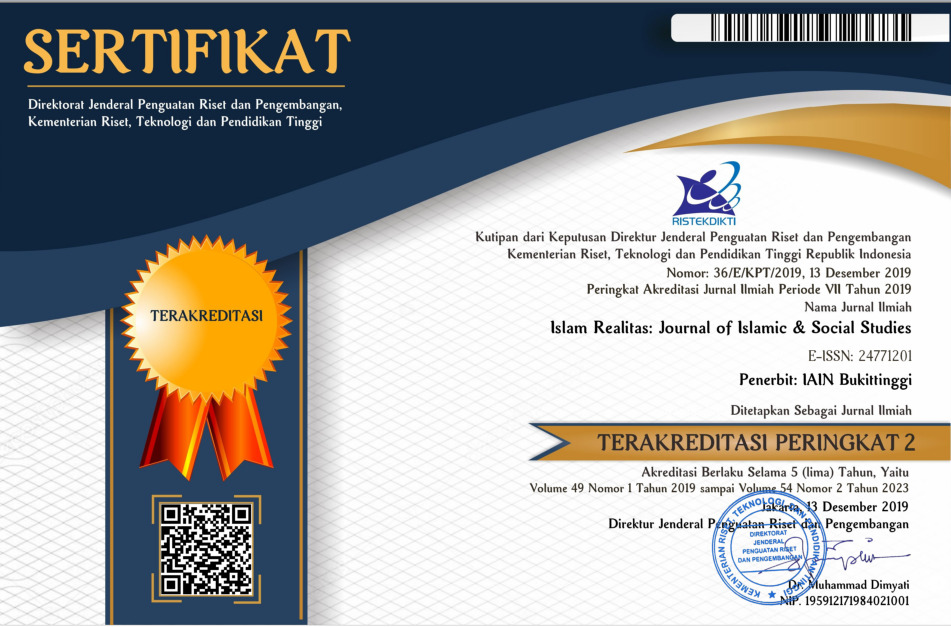Articulation of Indigenous Traditions in Tourism: A Case Study of Kenduri Sko in Kerinci, Jambi
Downloads
Additional Files
This study examines the practice of Kenduri Sko, one of the local traditions of the Kerinci people that has been rarely practiced. Since 2017, the government of Sungai Penuh City took over the management of the practice turning it into an annual tourist attraction called as the Festival of Kenduri Sko. This paper argues that the articulation of this indigenous tradition, and its combination with religion and tourism has stimulated the attempt to preserve indigenous practices through a strategic relationship between government officials and local actors. To show how this the case, we discuss the theory of indigenous religions and the theory of articulation. We use qualitative methods and conducted field studies on the Kerinci People who live in Sungai Penuh City. The article concludes that this kind of articulation has succeeded in placing indigenous peoples as the main actors of the initiative, where the government plays a supporting role in preserving the traditions. This article also recommends a synergistic relationship between the local government and the community to maintain the tradition through various events such as festivals, art performances, and other such projects.
Â
Penelitian ini mengkaji praktek Kenduri Sko sebagai salah satu tradisi lokal masyarakat Kerinci yang sudah jarang dilakukan. Sejak tahun 2017, Pemerintah Kota Sungai Penuh mengambil alih praktik tersebut sebagai ikon pariwisata yang disebut dengan Festival Kenduri Sko yang diadakan setiap tahun. Artikel ini berpendapat bahwa artikulasi adat istiadat, agama, dan pariwisata telah mendorong upaya pelestarian praktik adat melalui hubungan strategis antara pejabat pemerintah dan aktor lokal. Untuk membangun argumen ini, artikel ini mengelaborasi teori agama leluhur dan teori artikulasi. Artikel ini menggunakan metode kualitatif serta melakukan studi lapangan terhadap Masyarakat Kerinci yang berdomisili di Kota Sungai Penuh. Artikel ini menyimpulkan bahwa artikulasi semacam itu telah berhasil menempatkan masyarakat adat sebagai aktor utama dimana peran pemerintah sebagai aktor pendukung dalam pelestarian tradisi. Artikel ini juga merekomendasikan adanya hubungan yang sinergis antara pemerintah lokal dan masyarakat untuk mempertahankan tradisi luluhur melalui berbagai macam acara seperti festival, pergelaran seni dan semacamnya
Books
Asad, Talal, Genealogies of Religion: Discipline and Reasons of Power in Christianity and Islam (Baltimore: Johns Hopkins University Pr, 1993)
Cox, James L., From Primitive to Indigenous: The Academic Study of Indigenous Religions (Aldershot: Ashagate, 2007)
———, From Primitive to Indigenous: The Academic Study of Indigenous Religions (Burlington: Ashagate, 2007)
Geertz, Clifford, Islam Observed: Religious Development in Marocco and Indonesia (Chicago: University of Chicago Press, 1971)
———, The Religion of Java (Chicago: Chicago University Press, 1976)
Hall, Stuart, ‘Race, Articulation, and Societies Structured in Dominance’, in Black British Cultural Studies: A Reader, ed. by Houston A. Baker Jr, Manthia Diawara, and Ruth H. Lindborg (Chicago: University of Chicago Press, 1996)
Maarif, Samsul, ‘Dimensions of Religious Practice: The Ammatoans of Sulawesi, Indonesia’ (Arizona State University, 2012)
Masuzawa, Tomoko, The Invention of World Religions: Or, How European Universalism Was Preserved in the Language of Pluralism (Chicago and London: The University of Chicago Press, 2005)
Rangkuti, Nurhadi, ‘Prolog’, in Kerincimu Kerinciku: Dataran Tinggi Jambi Dalam Perspektif Arkeologi, ed. by Nurhadi Rangkuti (Yogyakarta: Penerbit Ombak, 2016)
Smith, Wilfred Cantwell, The Meaning and the End of the Religion (London: Mentor Books, 1962)
Woodward, Mark R., Islam in Java: Normative Piety and Mysticism in the Sultanate of Yogyakarta (Tucson: University of Arizona Press, 1989)
Journal
Berner, Ulrich, ‘The Notion of Syncretism in Historical And/or Empirical Research’, Historical Reflections, 27 (2001), 499–509
Berry, John W., ‘Acculturation: Living Successfully in Two Cultures’, International Journal of Intercultural Relations, 29 (2005), 697–712 <https://doi.org/10.1016/j.ijintrel.2005.07.013>
Clifford, James, ‘Indigenous Articulation’, The Contemporary Pacific, 13 (2001), 468–90
Kim, Soojung, Michelle Whitford, and Charles Arcodia, ‘Development of Intangible Cultural Heritage as a Sustainable Tourism Resource: The Intangible Cultural Heritage Practitioners’ Perspectives’, Journal of Heritage Tourism, 14 (2019), 422–35 <https://doi.org/10.1080/1743873X.2018.1561703>
Redfield, Robert, Ralph Linton, and Melville J. Herskovits, ‘Memorandum for the Study of Acculturation’, American Anthropologist, 38 (1936), 149–52
Situmorang, Ringkar, Teddy Trilaksono, and Arnold Japutra, ‘Friend or Foe? The Complex Relationship between Indigenous People and Policymakers Regarding Rural Tourism in Indonesia’, Journal of Hospitality and Tourism Management, 39 (2019), 20–29 <https://doi.org/10.1016/j.jhtm.2019.02.001>
Steward, Charles, ‘Syncretism and Its Synonyms: Reflections on Cultural Mixture’, Diacritics, 29 (1999), 40–62
Sunliyensar, Hafiful Hadi, ‘Ritual Asyeik Sebagai Akulturasi Antara Kebudayaan Islam Dengan Kebudayaan Pra-Islam Suku Kerinci’, Siddhayatra: Jurnal Arkeologi, 21 (2016), 107–28 <https://doi.org/https://doi.org/10.24832/siddhayatra.v21i2.23>
Voorhoeve, P., ‘Kerintji Documents’, Bijdragen Tot de Taal-, Land- En Volkenkunde / Journal of the Humanities and Social Sciences of Southeast Asia, 126 (1970), 369–99 <https://doi.org/10.1163/22134379-90002797>
Zandieh, Mahdi, and Zeinab Seifpour, ‘Preserving Traditional Marketplaces as Places of Intangible Heritage for Tourism’, Journal of Heritage Tourism, 15 (2020), 111–21 <https://doi.org/10.1080/1743873X.2019.1604714>
ZE, Deki Syaputra, ‘Rumah Gdang Dan Penyimpanan Artefak Budaya Di Kerinci’, Siddhayatra: Jurnal Arkeologi, 25 (2020), 59–75 <https://doi.org/10.24832/siddhayatra.v25i1.188>
Interviews
Afrizal, (Gelar Depati Sko Bajo Hitam), Interview, {22 Mei 2018}.
Dailami (Gelar Depati Rajo Mudo), Interview, {21 May 2018}.
Dinata, Septa (Traditional Leader of Desa Koto Baru Rawang), Interview, {10 May 2018}.
Haryadi, (Religious Actor), Interview, {21 May 2018}.
Sahi, Mak, Interview, {20 May 2018}.
Suharmi, Interview, {20 May 2018}.
Zulwachdi, (Government Employee of Dinas Pariwisata dan expert on Kerinci Culture), Interview, {1 Mei 2018}.
Authors who publish with this journal agree to the following terms:
- Authors retain copyright and grant the journal right of first publication with the work simultaneously licensed under a Creative Commons Attribution License that allows others to share the work with an acknowledgment of the work's authorship and initial publication in this journal.
- Authors are able to enter into separate, additional contractual arrangements for the non-exclusive distribution of the journal's published version of the work (e.g., post it to an institutional repository or publish it in a book), with an acknowledgment of its initial publication in this journal.
- Authors are permitted and encouraged to post their work online (e.g., in institutional repositories or on their website) prior to and during the submission process, as it can lead to productive exchanges, as well as earlier and greater citation of published work (See The Effect of Open Access).









